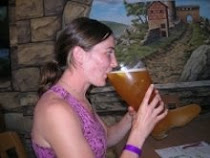I'm always looking for new and interesting brews to make. So when my aunt Carol came to me with an idea with a gluten free beer, I loved the challenge!
Gluten free brewing is part of a small movement of brewers to provide a "beer" that would not contain barley, wheat, or other sources of gluten. Folks with Celiacs Diseasse suffer from a disorder in which gluten attacks the inner lining of their intestines. Therefore many go on a strict gluten free diet.
Needless to say, the lack of barley and wheat is completely outside the realm of a convential brewer. We'll need to think outside the box. Many of the already produced gluten free beers, are made with Sorghum. Sorghum is a grain grass which does not contain sources of gluten. Doing a bit of research into sorghum brewing yields many people complaining of the aftertaste of sorghum beers. It seems sorghum can leave a sour twang in most brews that is usually unpleasant. So I tried to look in a different direction.
After a few hours of searching, I came across a webpage, where an individual sells roasted chestnut fruit chips for brewing. I also then found a forum post in HomebrewTalk about this very subject. I decided to try a mix of both sorghum and chestnut fruit chips. For the sorghum, I'll be using Briess White Sorghum Syrup.
Chestnut Mash
The chestnut mash is going to be different then anything I've ever done before. This will be a 24 hour mash schedule. Since chestnuts do not contain enzymes to convert starch to sugar (found in barley and wheat), we will need to add an artificial enzyme to the mash. I'll be using the amalayse enzyme. I'll likely start the strike water at around 180° to 190° F, to end with a mash temp around 158°. Amalayse is destroyed by higher temperatures, so once the boil begins, the amalayse will denature. The 24 hour mash schedule should hopefully release all the sugars that I can get from the chestnuts.I"ll end up sparging with enough water to get up to near my normal boil volume of 6.5 gallons.
Note that the chestnut chips will not lend that much sugar to the wort (likely up to 1.014). It will actually add more color and flavor then anything else. Therefore we'll need to up the sugar content. I will use the sorghum syrup simillar to liquid malt extract, as well as add 2.5 lbs of honey. I will use corn sugar to up the sugar content if any of my potential gravity calculations come out wrong. With the large amount of simple sugar, there will be little body. Maltodextrine will be used to add a bit more body to the beer.
Here's the official recipe:
Mash:
5.00 lb Fruit - Chestnut Chips (3.0 SRM - Mash 1 day) Grain
Amylase Enzyme (Mash 1 day) Misc
Boil:
60 min 3.00 lb White Sorghum Syrup 45H (3.0 SRM) Extract
60 min 0.00 lb Corn Sugar (Dextrose) (0.0 SRM) Sugar (depends on preboil grav)
60 min 2.50 lb Honey (1.0 SRM) Sugar
60 min 0.75 oz Centennial (60 min) Hops
10 min 0.25 oz Centennial (10 min) Hops
5 min 0.25 oz Pectic Enzyme (Boil 5.0 min) Misc (to help with pectin haze)
5 min 0.50 oz Orange Peel, Bitter (Boil 5.0 min) Misc
5 min 0.50 lb Maltodextrine (0.0 SRM) Sugar
Est Original Gravity: 1.051 SG
Est Final Gravity: 1.013
Estimated Alcohol by Vol: 4.92 %
Bitterness: 29.0 IBU
Calories: 43 cal/pint
Est Color: 4.6







